Nikon D60
-
-
Written by Gordon Laing
Nikon D60 design and controls
Externally the Nikon D60 is essentially identical to its predecessor the D40x, and the lower-end D40. All three share the honour of being Nikon’s smallest and lightest DSLRs to date; indeed, by measuring 126x94x64mm, they’re fractionally smaller than Canon’s EOS 400D / XTi, and a little lighter too when equipped with their respective batteries and 18-55mm kit lenses. You can see the D60 below alongside the Canon EOS 400D / XTi, and like the D40x before it, both models are likely to be fierce rivals.
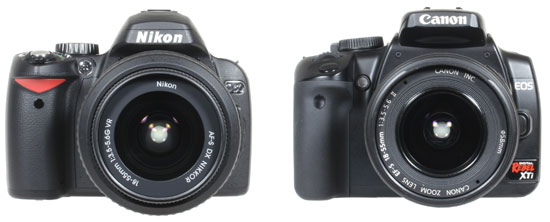 |
Despite its size and weight though the D60’s ergonomics and build quality don’t feel in any way compromised. Its plastic shell feels very solid and the body itself is comfortable to hold and use. The outer area of the grip is coated in a mottled rubber finish which along with Nikon’s trademark hooked inner area for your fingertips makes the camera feel very secure in your hand compared to rival budget models. It arguably feels classier in your hand than the 400D / XTi and since there’s plenty of space between the grip and lens barrel, there’s no finger pinching to worry about.
The D60’s new DX 18-55mm VR kit lens is however longer than the Canon EF-S 18-55mm, and with both cameras viewed from above, the Nikon kit is noticeably larger in this dimension. It’s unlikely to make much difference in real-life, but if your pocket or bag is going to be a tight fit, the Canon EOS 400D / XTi kit might squeeze into it slightly more easily.
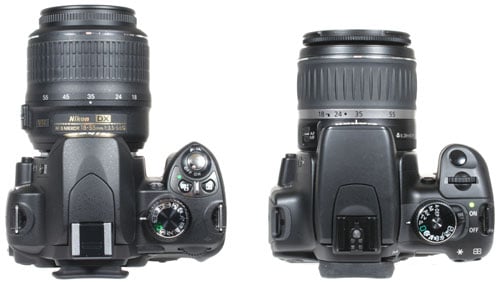 |
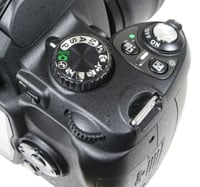 |
Like most budget DSLRs the bulk of the D60’s controls are distributed on the upper right and rear surfaces. The upper right side is home to the main command dial which offers Auto, Program, Manual, Aperture and Shutter Priority modes along with seven scene presets.
The rotary on / off switch is positioned around the shutter release, with buttons for adjusting the exposure compensation and Active D-Lighting alongside. The latter is one of the few external changes from the earlier D40x, where you’d previously have found an Info button, now rendered unnecessary by the eye proximity detectors under the viewfinder.
The rear surface features a similar number of buttons to say, the Canon 400D / XTi, but discreet labelling makes it look more approachable. The traditional four-way joypad-style control to the right of the screen for example has no labelling other than the OK button in the middle, although to be fair that’s because the buttons offer little more than menu and image navigation. Unlike the D80’s small and slightly stiff four-way controls though, the D60’s larger version feels more tactile and responsive.
A thumb dial in the upper right corner of the D60’s rear allows you to make exposure adjustments or scroll through images in playback, while a button labelled with a question mark in the lower left corner presents context-sensitive help on the screen. A button below it labelled with a letter ‘i’ is used to access a number of settings including White Balance, ISO, focusing, metering and quality modes from the default information screen.
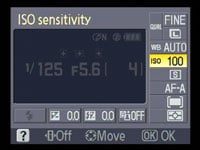 |
To adjust any of these you’ll first need to press the ‘i’ button with the screen already on, which switches the D60 to its ‘Quick Settings’ mode. This highlights one of the settings running down the right side or along the bottom of the screen. Next you use the four-way joypad to highlight the desired setting before pressing OK to finally access the available options. We have a demonstration in our video tour.
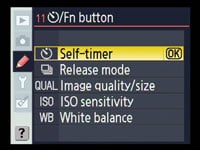 |
While we understand Nikon’s designed this system for first-time DSLR owners, it can become infuriatingly slow in practice for anyone who’s familiar with the system. Nikon really should have offered direct access to these menus by doubling-up the functions of either the buttons down the side of the screen or the four-way joypad, such as with the D80 or Canon 400D / XTi respectively.
On the upside the D60, like its predecessor and the D40, shows handy thumbnail examples of how each setting may be used in practice, several of which we’ll show below and on the next page. And offering some relief is a programmable function button on the body’s left side, which by default operates as a self-timer, but can be set to alternatively offer direct access to either shooting mode, quality, ISO or white balance settings.
Nikon D60 metering and exposures
The Nikon D60 offers three metering modes: Spot, Center-weighted and 3D Colour Matrix Metering II, the latter employing the same 420-segment RGB sensor as its predecessor – and as before, you’ll need a Type G or D lens to support the range information in this system, such as the supplied kit lens.
The D60 offers shutter speeds from 1/4000 to 30 seconds plus Bulb in third-stop increments, while exposure compensation is available in a broad +/-5 EV range, again in one-third increments. For sensitivity, processing and continuous shooting details, see our Features page.
Nikon D60 flash
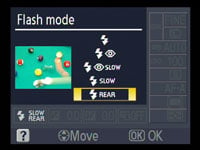 |
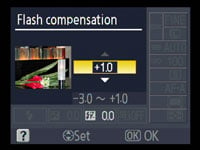 |
The Nikon D60 is equipped with both a popup flash and a hotshoe for external flashguns. Flash compensation and power level is adjustable, and you can also choose from red-eye, slow-sync and rear-curtain options.
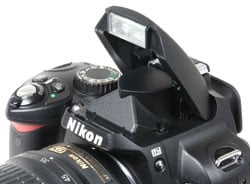 |
The built-in flash can either popup automatically or by pressing a button on the side of the D60, and once you’re finished with it, just push it back into place. Like the D40x, the D60’s maximum flash sync speed is an average 1/200, so once again the entry-level D40 scores here with its much faster 1/500 flash sync speed, inherited from the earlier D50.
If you mount a compatible flashgun like the SB-400, SB-800 or SB-600, the D60 can support the Nikon Creative Lighting System (CLS) which offers iTTL control. And if you’re using an SB-800 or SU-800 on the D60, you can enjoy wireless control of other compatible Speedlights.
Nikon D60 Viewfinder
The Nikon D60 employs a penta-mirror type optical viewfinder which delivers 95% coverage and 0.8x magnification. In practice it doesn’t appear as big or bright as the D80’s excellent penta-prism viewfinder, although it looks roughly equivalent to that of the Canon EOS 400D / XTi. To our eyes, the D60’s viewfinder appeared fractionally brighter than the 400D / XTi when fitted with their respective kit lenses (same apertures) presumably due to differences in their actual focusing screens. Since the D60 does not feature Live View, the viewfinder is used for all composition.
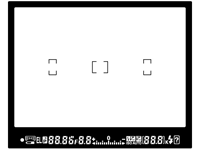 |
The D60’s viewfinder is dominated by the three focus point indicators with outlines which illuminate when active; this looks a little classier than the dots which illuminate on the EOS 400D / XTi’s focus points, although the latter does at least feature a considerably more sophisticated nine-point AF system. Sadly the on-demand viewfinder LCD grid lines of the D80 aren’t available here.
In addition to the usual exposure details and compensation scale, the D60’s viewfinder can also display a flashing question mark as a warning when it believes the picture may be spoilt by a technical aspect; pressing the question mark button on the back of the camera then presents some helpful advice on the main screen, such as ‘Lighting is poor, flash recommended’.
Nikon D60 screen and menus
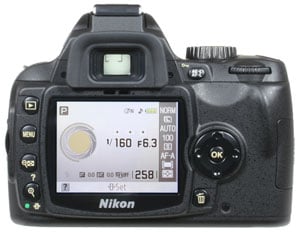 |
The Nikon D60 is equipped with the same 2.5in / 230k pixel screen as its predecessor. It’s bright and detailed, and unlike most Nikon DSLRs, doesn’t come with a clip-on protective cover. Like most budget DSLRs these days, the D60 uses its main colour screen to display all shooting information, and in a welcome improvement over its predecessor, Nikon’s now fitted proximity detectors under the viewfinder to switch the screen off when you’re composing your shot.
Like its predecessor and the D40, the D60 offers the choice of two main presentation styles for the exposure details: the default Graphic format accompanies the figures with a graphical representation of the aperture iris surrounded by marks for the shutter speed, while the optional Classic format emulates the LCD status screens which adorn the top panels of higher-end DSLRs.
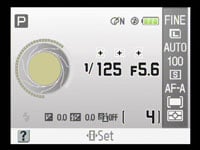 |
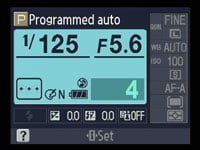 |
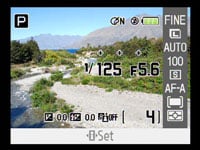 |
| |||||
It’s nice to have the choice of styles and even the option to use your own image as wallpaper; you can even switch the colour scheme of the Graphic and Classic formats between White, Black and Orange.
Like all DSLRs which use their main colour screens to show information, there’s a wealth of details. The shutter speed and aperture sensibly take centre stage with shooting mode, optimise image setting and battery life running along the top, and flash, exposure compensation, Active D-Lighting mode and shots remaining along the bottom.
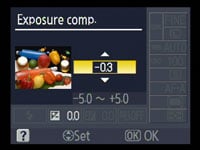 |
Running down the right side of the screen are the current quality, white balance, ISO, Release Mode, AF and metering mode settings and to adjust any of them simply press the ‘i’ button in the bottom left corner, use the four-way controller to highlight the desired option and click OK. You’ll then be presented with a screen of relevant options and in most cases an example image of where or how you might use each setting. The thumbnails are certainly helpful, but as mentioned above, we found the required number of button presses to access each setting page a little laborious.
In a nice feature borrowed from Sony’s Alpha DSLRs (and originally from Konica Minolta before that), the D60 now rotates its shooting information as you turn the camera on its sides for portrait aspect shots – this way the text always remains upright on the screen and we have a demo in our video tour. The graphical representation of the aperture may disappear as the screen rotates, and as soon as you press the ‘i’ button to change anything you’ll also be returned to the landscape orientation, but it’s still a nice touch.
We’re pleased to report the D60’s inherited the classy-looking menus of its higher-end counterparts, which are arguably the best-looking on the DSLR market today. There’s also an impressive 19 custom functions (once Full has been selected in Setup) and Nikon’s sensibly kept the D80’s handy facility of delivering context-sensitive help whenever you press the question mark button – this is great if you’re in a mode or setting page and want some guidance on what it does. Sometimes you’ll see the question mark blinking in the corner of the screen, in which case the D60 believes something’s wrong and wants to make a suggestion, such as to use the flash. If only all cameras were this friendly.
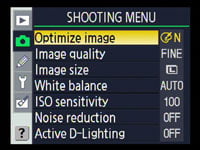 |
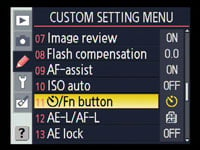 |
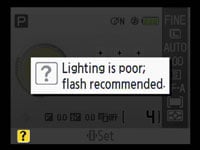 |
Also inherited from the D80 is the Retouch menu which offers a variety of in-camera adjustments which are applied to existing images. These include filter simulations, red-eye corrections, cropping, and the D-Lighting tonal enhancement. New to the D60 is a starburst (cross screen) filter effect. Like the D80, these are good fun, and arguably better suited to the D60’s target market, but they’re only useful if you’re truly computer-phobic or need to perform a quick edit before printing direct from the camera or memory card.
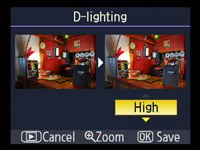 |
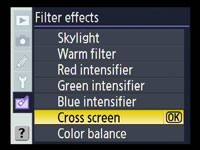 |
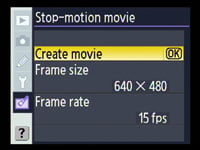 |
Another new addition to the D60’s Retouch menu is Stop Motion which can assemble a sequence of up to 100 still images into a movie clip exported in the AVI format. You can switch the output resolution between 640×480, 320×240 and 160×120 pixels, and the frame rate from 3, 6, 10 or 15fps. We created a movie with 100 frames at the VGA 15fps setting and it came out measuring 14.6MB and lasting six seconds.
It’s a shame there’s no smooth 30fps option nor a built-in Intervalometer which will automatically take the photos for you, but it’s still a fun addition and the closest we’ve seen to a movie mode on a DSLR to date. See our video tour for a demonstration.
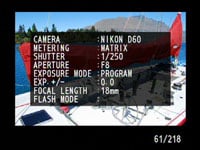 |
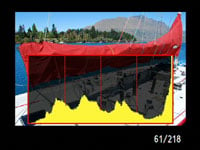 |
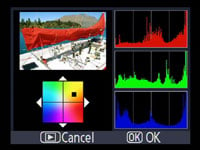 |
During playback you can cycle through a number of pages showing shooting information and a brightness histogram. There’s no option to view RGB histograms instead, but again the D60’s target market are unlikely miss them. That said, by selecting the Colour Balance Filter option from the Retouch menu, you’re presented with RGB histograms to show your adjustments. So if needs be, you could always select this option just to view the RGB histograms even if you had no intention of adjusting the colour balance.
Nikon D60 battery and connectivity
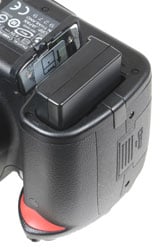 |
The Nikon D60 employs the same rechargeable EN-EL9 Lithium Ion battery as its predecessor. Rated at 1000mAh, Nikon claims this is good for 500 shots under CIPA conditions using the kit lens with VR enabled, and a mains recharger is supplied in the kit. Battery life is indicated by a three segment graphic on the main screen, although unlike the D80, there’s no support for Nikon’s Fuel Gauge system which provides an accurate feedback of the battery life and condition (albeit via a menu option). Like its predecessor, there’s no official battery grip for the D60, although third party models are available.
The Nikon D60 has an SD memory card slot behind a door on the right side and the camera can handle SDHC cards; like most DSLRs no card is supplied as standard. If more than 1000 pictures are available, the number is rounded and abbreviated to read, say, 1.1K for 1100 photos.
Behind a flap on the left side are a USB port, TV output and a recessed reset button. A USB cable is supplied, but in a money-saving exercise, the TV cable is an optional accessory.




